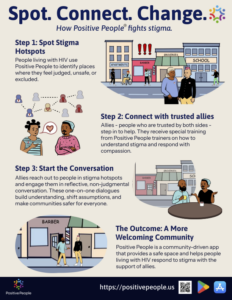Everyone knows stigma when they feel it—but how do we change it?
At Positive People, we’re building something new: a way for communities to not only see where stigma shows up, but also do something about it—together. We know from research and lived experience that stigma isn’t just about ideas. It’s about relationships, spaces, and power—and changing it takes more than posters or awareness days. That’s why we’re creating tools to make stigma visible—and actionable.
Step 1: Spot the Hotspots
The process begins with you—members of the community using the Positive People app to share moments when you felt judged, excluded, or unwelcome. Maybe it was a clinic where you were treated differently. A barbershop where people made assumptions. A job interview that ended too quickly.
You’ll be able to take a photo of the place, tell your story, and tag it as a potential stigma hotspot. As more people contribute, patterns will emerge. When many people report similar experiences in the same place, the app flags it as a critical hotspot—an opportunity for change.
Step 2: Connect with Allies
Once a hotspot has been identified, the app invites community members to help find allies—people who are trusted, not living with HIV themselves, and who have a personal or professional connection to the hotspot. Maybe they work there. Maybe they have a family member who does. Maybe they know the owner.
Allies aren’t expected to fix everything. We just ask if they’re willing to learn more and consider helping.
Step 3: Support from a Trainer
If an ally is interested, we connect them with a trainer—someone from the Positive People community who’s been trained to offer guidance, encouragement, and resources. Some allies might just want a few tips and talking points. Others might want a deeper conversation or ongoing coaching. Our platform lets the level of support match the moment.
Step 4: Start the Conversation
With support in hand, the ally reaches out to someone inside the hotspot—a coworker, manager, staff member—and engages in a reflective, respectful conversation. Not a confrontation. Not a script. Just one person reaching out to another with the goal of building understanding and making space for change.
When the conversation happens, the ally logs it in the app. The hotspot’s status is updated so others can see that change is in progress.
Step 5: See What’s Changed
Once a conversation has taken place, the app invites users to revisit the hotspot. Has the environment improved? Are staff acting differently? Is the space more welcoming?
Sometimes change is immediate. Sometimes it takes more than one conversation. But each interaction builds momentum—and the story of transformation is visible in the app.
Why This Matters
This approach is based on contact theory, a well-established framework showing that people’s beliefs change most effectively through trust-based, personal interaction. By pairing lived experience with relationship-based advocacy, Positive People helps communities respond to stigma in real time.
Coming Soon
These features are still in development—but they’re coming soon. And when they launch, we’ll be inviting community members, allies, and trainers to help test and shape the tools together.
Stigma doesn’t disappear on its own. But with the right tools—and the right people—we can build communities where everyone belongs.
Want to join the movement? Sign up or login at https://positivepeople.us!
Write A Comment